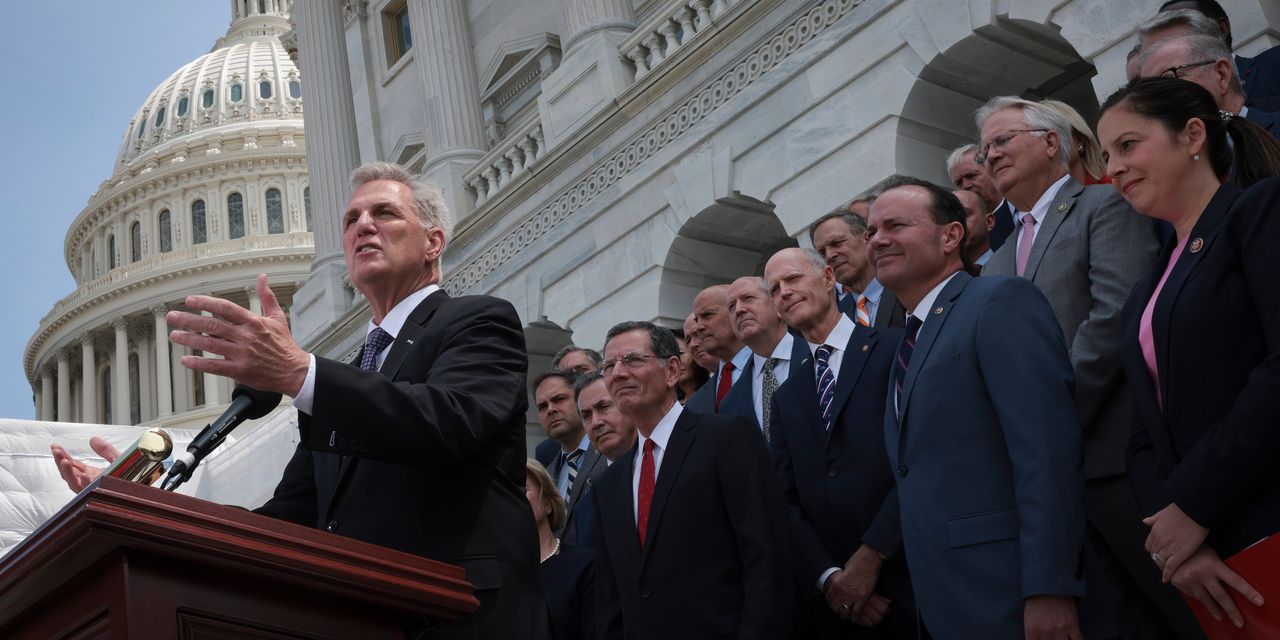With U.S. Treasury Secretary Janet Yellen’s “X date” for Congress to raise the federal debt ceiling just two weeks away, some on Wall Street are seeing an opportunity in cheap option contracts that would yield large returns if U.S. stocks sold off like they did during the debt-ceiling drama in Congress in 2011.
A team of equity derivative strategists at Bank of America has told clients that S&P 500 index put options
SPX,
expiring in the weeks ahead look “cheap” when considering the high risk for a selloff.
In a research note, the team said clients could reap returns of up to 30 times the upfront premium paid by buying certain types of options that would pay off if the S&P 500 fell by 10% or more, such as puts on the S&P 500, calls on the Cboe Volatility Index, otherwise known as the Vix, or calls tied to an exchange-traded fund that tracks the price of gold.
Right now, these options are only pricing in a “4% to 6%” chance of this happening but the Bank of America team believes the odds of such an outcome are much higher.
Between July 22 and Oct. 3, 2011 for example the S&P 500 fell 22%, according to FactSet. Stocks continued to fall even after a debt-ceiling deal passed Congress that year as Standard & Poor’s stripped the U.S. of its AAA credit rating shortly after.
“Despite managing to raise the debt ceiling in time, the 2011 episode caused a large spike in volatility and triggered sharp moves across asset classes,” the Bank of America analysts said in the note.
“One can argue that market stress contributed to that resolution, and that the same may be needed this time around. Yet various asset classes remain seemingly calm about the current (arguably riskier) situation.”
Some on Wall Street fear that Congress might only be motivated to strike a deal if markets turn chaotic.
“Nobody thinks the U.S. is going to default, but nobody thinks this is going to be resolved quickly, so everyone thinks it could take a big selloff in stocks to motivate them,” said Amy Wu Silverman, equity derivative strategist at RBC Capital Markets, during a phone interview with MarketWatch.
See: Why it might take ‘a stock-market meltdown’ to resolve the debt-ceiling standoff
Silverman pointed to several derivatives-market indicators showing that demand for so-called tail risk hedges, or put options on the S&P 500 that would pay off if stocks fell by roughly 10% or more, has increased somewhat in recent weeks.
The Bank of America team also noted that there have been differences between how markets have reacted to the debt ceiling impasse. Treasury yields have been much more sensitive than stocks as yields on Treasury bills have shot above 5% recently.
The Nations TailDex, a gauge of demand for options that would pay off if the S&P 500 fell 10% or more, stood at 15.12 on Thursday. It traded as high as 22 back in March.
Silverman also noted that demand for call options linked to gold-tracking ETFs has risen since March.
Still, with the Vix still below 20, which is equivalent to the index’s long-term average over the last 20 years, there are many on Wall Street who fear markets are becoming complacent with the S&P 500 stuck in such a narrow range in recent months.
U.S. stocks have been much more placid in 2023 than in 2022, when daily moves of 1% or more in either direction were relatively common.
For the first time since December 2019, the S&P 500 has logged six consecutive weeks without a weekly move of 1% in either direction as of Thursday, according to Dow Jones Market Data
Recently, stocks have been stuck in a tight trading range: the difference between the S&P 500’s 30-day trailing high and 30-day trailing low stands at 3.4%, according to a team of analysts at Bespoke Investment Group — is the narrowest spread since 2018.
Despite this, the S&P 500 and Nasdaq have risen in 2023, erasing some of their losses from 2022, when stocks suffered their worst calendar-year pullback since 2008, according to FactSet.
The S&P 500 has risen more than 9% this year as of Tuesday’s close, while the Nasdaq Composite is up more than 20%.
To be sure, most of these gains have been driven by the 10 biggest stocks in the S&P 500, the megacap companies in the technology sector, like Meta Platforms Inc.
META,
Apple Inc.
AAPL,
and Microsoft Corp.
MSFT,
These top 10 stocks hold a 29% weight in the S&P 500, and are responsible for around 70% of year-todate performance, according to Ross Mayfield, investment strategy analyst at Baird.
See: The S&P 500 is top-heavy with tech. Here’s what that says about future stock-market returns
Kris Sidial, co-CIO at the Ambrus Group, a tail-risk fund that aims to help clients profit from selloffs, told MarketWatch that he believes investors aren’t prepared for a sudden selloff in stocks.
“There is a lot of complacency in the market,” Sidial said during a phone call with MarketWatch.
U.S. stocks finished higher on Thursday as optimism about a deal to raise the debt ceiling has persisted in recent days. House Speaker Kevin McCarthy told CNN on Thursday that he expects a bill to raise the debt ceiling to hit the floor next week.
On Thursday the S&P 500 rose 39.28 points, or 0.9%, to 4,198.05, surpassing a high from early February to close at the highest level since August while the Nasdaq Composite
COMP,
rose by 188.27 points, or 1.5%, to 12,688.84, also the highest since August, according to FactSet. The Dow Jones Industrial Average
DJIA,
gained 115.14 points, or 0.3%, to 33,535.91.
Read the full article here




